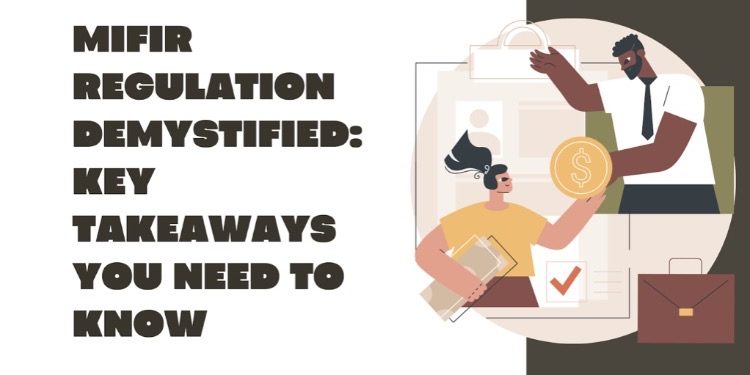Firms across the European Union must comply with financial regulations. The Markets in Financial Instruments Regulation (MiFIR) leads this effort. MiFIR aims to foster more transparent and efficient markets by standardizing rules across trading platforms and ensuring fair practices.
The recent 2024 updates have introduced significant changes, making it imperative for firms to stay informed and adapt their operations accordingly. This blog will break down the key aspects of MiFIR, including enhanced reporting obligations, stricter rules for algorithmic trading, and cross-border collaboration efforts.
If you want to stay ahead of these regulatory demands, understanding these changes is a critical first step toward compliance and operational efficiency.
Core Purpose: Streamlining Financial Market Operations
The core goal of the mifir regulation is to make financial markets in the European Union more efficient and transparent.
Breaking down the barriers between the EU financial markets, MiFIR prepares for even more effective cross-border trading; it provides an aggressive objective of improving market liquidity by up to 20%.
MiFIR achieves this by:
1. Boosting transparency: Investment firms have to share detailed information on transactions, ensuring market integrity and investor protection.
2. Creating a unified framework: This regulation proves to be a comprehensive one because it applies equally to every trading platform so that the field is leveled for all market participants.
3. Enhancing investor protection: By mandating clear and comprehensive reporting, MiFIR helps investors make more informed decisions.
Scope Expansion and Critical Revisions under MiFIR (2024 Update)
The financial world is ever-evolving, and MiFIR has adapted to keep pace. The 2024 update brings significant changes that market participants need to be aware of:
Expanded Scope
● New financial instruments: The regulation now covers additional instruments, including certain commodity derivatives.
● Enhanced OTC reporting: Over-the-counter (OTC) derivatives are now subject to more stringent reporting requirements.
1. Consolidated market data tapes: Investors will have access to real-time, comprehensive trading data across the EU.
2. Stricter reporting obligations: Investment firms must now submit detailed reports covering 65 data fields for each transaction.
3. Emphasis on accuracy and timeliness: The new requirements stress the importance of precise and prompt reporting.
These updates reflect the growing complexity of financial markets and the need for more comprehensive oversight.
Transaction Reporting Requirements and Trade Transparency
Transparency is one of the major objectives under MiFIR in building up fair and efficient financial markets. As a result, firms are required to publicly report all transactions.
These rules thus establish confidence, avoid market manipulation, and ensure investors have verified information to be available to them.
Post-Trade Transparency Mandates
● Every transaction must be disclosed to the public with key details such as trade prices, volumes, and timestamps.
● Reports should be made in real-time or as close to real-time as possible, so the information stays relevant.
● Larger trades that could disrupt the market may have delayed reporting, but only for a limited time to protect transparency.
● This ensures all participants, big or small, have access to the same market data.
OTC Derivatives Reporting
● MiFIR now includes over-the-counter (OTC) derivatives in its reporting rules, which were previously less regulated.
● These derivatives must be reported publicly after the trade, giving regulators and investors more visibility.
● This aligns with global standards, helping to reduce risks and ensure consistent oversight across markets.
Consequences of Non-Compliance
Failing to meet MiFIR’s reporting obligations can result in serious penalties, such as:
● Fines up to €5 million or 10% of the firm’s annual revenue.
● Reputational damage can reduce investor trust and impact the firm’s business.
● Trading suspension stops firms from participating in the market until they resolve the issues.
These rules highlight the importance of robust reporting systems to avoid mistakes and meet deadlines. Automated tools, regular audits, and staff training help firms stay compliant, reducing the risk of penalties and ensuring smooth operations.
Impact on Algorithmic and High-Frequency Trading (HFT)
As algorithmic and high-frequency trading becomes more prevalent, MiFIR has introduced specific requirements to ensure these practices don’t disrupt market stability:
Requirements for Algorithmic Traders
1. Monitoring systems: Firms must implement robust systems to monitor and control potential market disruptions.
2. Risk management: Comprehensive frameworks are required to mitigate risks associated with algorithmic trading.
● HFT firms must ensure they don’t gain unfair advantages over other traders.
● Practices that could lead to market manipulation are strictly prohibited.
● Firms engaged in algorithmic trading must have circuit breakers and other safeguards in place.
● Regular testing and reporting of trading algorithms are mandatory.
Cross-border Regulatory Collaboration
Financial markets don’t operate in isolation, and neither does MiFIR. The regulation emphasizes cross-border cooperation to ensure consistent enforcement and prevent regulatory arbitrage:
ESMA’s Coordinating Role
The European Securities and Markets Authority (ESMA) plays a crucial part in:
● Coordinating enforcement across EU member states
● Ensuring consistent interpretation of MiFIR rules
● Facilitating information sharing between national regulators
Alignment with Non-EU Jurisdictions
MiFIR also considers the global nature of financial markets by:
● Seeking alignment with regulatory frameworks in major non-EU financial centers
● Working to prevent regulatory gaps that could be exploited
While MiFIR focuses on the practical aspects of financial transactions, it works in tandem with the Markets in Financial Instruments Directive II (MiFID II):
● MiFID II sets the broader policy framework
● MiFIR provides the specific rules and requirements
● Together, they create a comprehensive regulatory environment
Navigating the Challenges of MiFIR Compliance
Complying with MiFIR can be complex, but it’s essential for firms operating in EU financial markets. Here are some key challenges and best practices:
● Invest in technology: Implement robust, automated reporting systems
● Staff training: Ensure all relevant personnel understand MiFIR requirements
● Regular audits: Conduct internal reviews to identify and address compliance gaps
● Engage with regulators: Maintain open communication with regulatory bodies for clarity on requirements
Manual vs. Automated MiFIR Reporting
| Aspect | Manual Reporting | Automated Reporting |
| Accuracy | Prone to human error | Higher accuracy due to system checks |
| Speed | Slower, time-consuming | Real-time or near real-time reporting |
| Cost | Lower initial cost, higher long-term labor costs | Higher initial investment, lower long-term costs |
| Scalability | Limited by human capacity | Easily scalable to handle increased volume |
| Audit Trail | May be incomplete or inconsistent | Comprehensive and easily accessible |
| Regulatory Updates | Requires manual implementation | Can be updated systematically |
Turning MiFIR Challenges into Opportunities
MiFIR has become a cornerstone of financial market regulation in the EU, driving transparency, fairness, and stability.
The 2024 revisions reinforce the need for accurate reporting and responsible trading practices, requiring firms to adopt advanced systems and processes.
Although the path may be a bit challenging, this process gives businesses at least some chance to win trust, become more efficient, and finally to shore up the market position.
With this, there was congruence with MiFIR that, other than reducing risks of non-compliance, unlocked growth opportunities in a rather highly regulated environment.
With the right strategies such as automated reporting systems, ongoing staff training, and regular audits, firms can meet MiFIR’s requirements confidently and capitalize on the benefits of a well-regulated financial market.
Frequently Asked Questions (FAQs)
What are the penalties for non-compliance with MiFIR’s reporting obligations?
Penalties can be severe, including fines of up to €5 million or 10% of a firm’s annual revenue. Additionally, firms may face reputational damage and potential suspension from trading activities.
How can firms ensure they stay compliant with MiFIR’s evolving requirements?
Firms should invest in robust, automated reporting systems, conduct regular internal audits, provide ongoing staff training, and maintain open communication with regulatory bodies to stay informed about updates and interpretations of MiFIR requirements.
What is the role of ESMA in enforcing MiFIR?
ESMA plays a crucial role in coordinating MiFIR enforcement across EU member states. It ensures consistent interpretation of the rules, facilitates information sharing between national regulators, and works to align MiFIR with global financial regulations.











































































